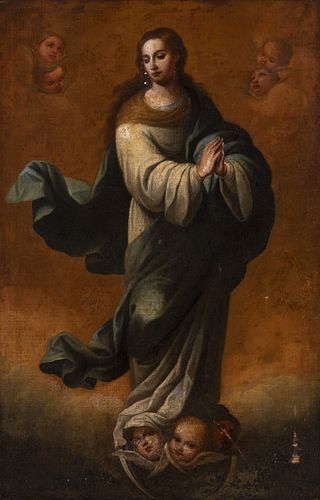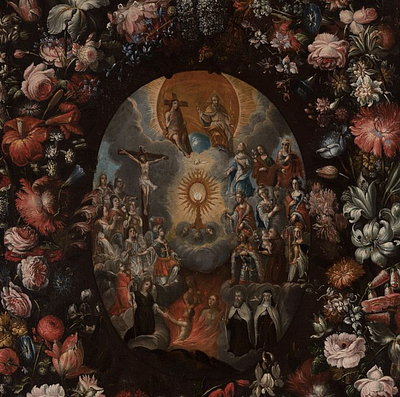School of BARTOLOMÉ ESTEBAN MURILLO; late seventeenth century. "Immaculate Conception". Oil on canvas.
Lot 30
About Seller
Setdart Auction House
Carrer Aragó 346
Barcelona
Spain
Setdart Subastas was born in 2004 and is currently the first online art auction in Spain with solidity, prestige and reliability guaranteed by our more than 60,000 users. Setdart has a young, dynamic and enterprising team ready to successfully manage the purchase and sale of art works through custom...Read more
Estimate:
EUR€1,000 - EUR€1,500
$1,086.96 - $1,630.43
Absentee vs Live bid
Two ways to bid:
- Leave a max absentee bid and the platform will bid on your behalf up to your maximum bid during the live auction.
- Bid live during the auction and your bids will be submitted real-time to the auctioneer.
Bid Increments
| Price | Bid Increment |
|---|---|
| EUR€0 | EUR€10 |
| EUR€200 | EUR€25 |
| EUR€500 | EUR€50 |
| EUR€1,000 | EUR€100 |
| EUR€3,000 | EUR€200 |
| EUR€5,000 | EUR€500 |
| EUR€10,000 | EUR€1,000 |
| EUR€20,000 | EUR€2,000 |
| EUR€50,000 | EUR€5,000 |
About Auction
By Setdart Auction House
Jul 14, 2021
Set Reminder
2021-07-14 06:30:00
2021-07-14 06:30:00
America/New_York
Bidsquare
Bidsquare : OLD MASTERS
https://www.bidsquare.com/auctions/setdart-auction-house/old-masters-7202
Setdart Auction House sofia@setdart.com
Setdart Auction House sofia@setdart.com
- Lot Description
School of BARTOLOMÉ ESTEBAN MURILLO; late seventeenth century. "Immaculate Conception". Oil on canvas. Presents coves, repainting and scratches. Size: 165 x 108 cm; 189 x 131 cm (frame). Several centuries before the Vatican Council I defined the dogma of faith in 1854. At the end of the Middle Ages the need to give iconographic form to this idea was born, and the model of the Apocalyptic Woman of St. John was taken, maintaining some elements and modifying others (the Apocalyptic Woman is pregnant, but not the Immaculate). The definitive image came to fruition in the 16th century, apparently in Spain. Following a Valencian tradition, the Jesuit Father Alberro had a vision of the Immaculate Conception and described it to the painter Juan de Juanes so that he could capture it as faithfully as possible. It is an evolved iconographic concept, sometimes associated with the theme of the Coronation of the Virgin. Mary appears standing, dressed in a white tunic and blue mantle, with her hands crossed on her chest, with the moon at her feet (in memory of Diana's chastity) and stepping on the infernal serpent (symbol of her victory over Original Sin). Around his head, like a halo, he wears the twelve stars, symbol of fullness and allusive to the twelve tribes of Israel. Most of these images are accompanied, in the painting, by the Marian symbols of the litanies and psalms, such as the mystical rose, the palm tree, the cypress, the closed orchard, the ark of Faith, the door of Heaven, the ivory tower, the sun and the moon, the sealed fountain, the cedar of Lebanon, the mirror without stain, the morning star, etc. The work follows models of Murillo's school, especially the painter Domingo Matinez (Seville, 1688 - 1749). This artist was trained in his hometown, being Lucas Valdés one of his teachers. The sources indicate that he was appreciated in his time, given that we find important commissions such as those received from the archbishop of Seville, for whom he made several paintings destined for the cathedral of the Andalusian capital and the church of Nuestra Señora de la Consolación in Umbrete. Likewise, during the stay of Philip V's court in Seville (1729-33) he maintained a relationship with French painters in the service of the king, such as Jean Ranc and Louis-Michel van Loo, whose influence will be evident in his work, combined with the direct inheritance of Murillo. On the other hand, it was precisely Ranc who proposed Martínez as court painter, an offer that the painter, however, rejected, since he did not wish to move to Madrid with the king. He had several disciples, and we know that his workshop trained Andrés de Rubira, Pedro Tortolero and Juan de Espinal, the latter painter who would eventually become his son-in-law and heir to the family workshop. His first important work was the decorative set of the church of the Colegio de San Telmo, with paintings on the life of Christ and his relationship with the sea, made in 1724. Six years later he painted two large paintings for the Convent of Santa Paula in Seville. In this same decade of 1730 he also produced individual works and sets for churches in Seville and its province, always with religious themes, as well as the portrait of Archbishop Luis de Salcedo y Azcona for the Archbishop's Palace of Seville (1739). He was equally prolific in the last decade of his life, when he created tempera decorations for the churches of Santa Ana and San Luis de los franceses in Seville, as well as several canvases. His last work, produced around 1748, was a set of eight canvases representing the great masquerade held in Seville in June of the previous year on the occasion of the accession to the throne of Fernando VI. Works by Martínez are currently preserved in the Museum of Fine Arts in Seville.
- Shipping Info
-
In-house shipping available. Please inquire at admin@setdart.com.
-
- Buyer's Premium



 EUR
EUR CAD
CAD AUD
AUD GBP
GBP MXN
MXN HKD
HKD CNY
CNY MYR
MYR SEK
SEK SGD
SGD CHF
CHF THB
THB















